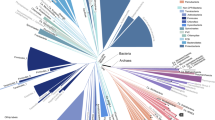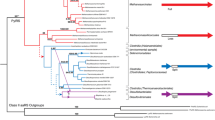Abstract
Publication of the genome sequence of Thermotoga maritima highlighted its extensive sharing of genes with archaea. Subsequent analyses have shown that the amount of gene exchange is less than first estimated and the addition of new genome sequences to databases is likely to make future enumerations of archaeal gene exchanges more difficult. We present a preliminary use of a new algorithm that maps the relationships between genes to reveal communities of organisms that have shared genes through either vertical or horizontal acquisitions. This method is evaluated by examinations of the evolutionary histories of oligosaccharide ABC transporter genes and genes encoding a putative membrane bound oxidoreductase (mbx). Although further refinements are necessary, this method promises to provide a better picture of evolutionary relationships than conventional phylogenetic trees.
Access this chapter
Tax calculation will be finalised at checkout
Purchases are for personal use only
Similar content being viewed by others
References
Nelson KE, Clayton RA, Gill SR, Gwinn ML, Dodson RJ, Haft DH et al (1999) Evidence for lateral gene transfer between Archaea and Bacteria from genome sequence of Thermotoga maritima. Nature 399(6734):323–329
Zhaxybayeva O, Swithers KS, Lapierre P, Fournier GP, Bickhart DM, Deboy RT et al (2009) On the chimeric nature, thermophilic origin, and phylogenetic placement of the Thermotogales. Proc Nat Acad Sci U S A 106(14):5865–5870
Koski LB, Golding GB (2001) The closest BLAST hit is often not the nearest neighbor. J Mol Evol 52(6):540–542
Koonin EV, Makarova KS, Aravind L (2001) Horizontal gene transfer in prokaryotes: quantification and classification. Annu Rev Microbiol 55:709–742
Hsiao W, Wan I, Jones SJ, Brinkman FS (2003) IslandPath: aiding detection of genomic islands in prokaryotes. Bioinformatics 19(3):418–420
Podell S, Gaasterland T (2007) DarkHorse: a method for genome-wide prediction of horizontal gene transfer. Genome Biol 8(2):R16
Podell S, Gaasterland T, Allen EE (2008) A database of phylogenetically atypical genes in archaeal and bacterial genomes, identified using the DarkHorse algorithm. BMC Bioinformatics 9:419
Tettelin H, Masignani V, Cieslewicz MJ, Donati C, Medini D, Ward NL et al (2005) Genome analysis of multiple pathogenic isolates of Streptococcus agalactiae: implications for the microbial “pan-genome”. Proc Natl Acad Sci U S A 102(39):13950–13955
Lapierre P, Gogarten JP (2009) Estimating the size of the bacterial pan-genome. Trends Genet 25(3):107–110
Sicheritz-Pontén T, Andersson SGE (2001) A phylogenetic approach to microbial evolution. Nucl Acids Res 29(2):545–552
Frickey T, Lupas AN (2004) PhyloGenie: automated phylome generation and analysis. Nucleic Acids Res 32(17):5231–5238
Noll KM, Thirangoon K (2009) Interdomain transfers of sugar transporters overcome barriers to gene expression. Methods Mol Biol 532:309–322
Nanavati DM, Thirangoon K, Noll KM (2006) Several archaeal homologs of putative oligopeptide-binding proteins encoded by Thermotoga maritima bind sugars. Appl Environ Microbiol 72(2):1336–1345
Silva PJ, van den Ban EC, Wassink H, Haaker H, de Castro B, Robb FT et al (2000) Enzymes of hydrogen metabolism in Pyrococcus furiosus. Eur J Biochem 267(22):6541–6551
Calteau A, Gouy M, Perriere G (2005) Horizontal transfer of two operons coding for hydrogenases between bacteria and archaea. J Mol Evol 60(5):557–565
Price MN, Dehal PS, Arkin AP (2010) FastTree 2–approximately maximum-likelihood trees for large alignments. PLoS One 5(3):e9490
Guindon S, Gascuel O (2003) A simple, fast, and accurate algorithm to estimate large phylogenies by maximum likelihood. Syst Biol 52(5):696–704
Bridger SL, Clarkson SM, Stirrett K, DeBarry MB, Lipscomb GL, Schut GJ et al (2011) Deletion strains reveal metabolic roles for key elemental sulfur-responsive proteins in Pyrococcus furiosus. J Bacteriol 193(23):6498–6504
Schut GJ, Bridger SL, Adams MWW (2007) Insights into the metabolism of elemental sulfur by the hyperthermophilic archaeon Pyrococcus furiosus: characterization of a coenzyme A-dependent NAD(P)H sulfur oxidoreductase. J Bacteriol 189(12):4431–4441
Schut GJ, Boyd ES, Peters JW, Adams MW (2013) The modular respiratory complexes involved in hydrogen and sulfur metabolism by heterotrophic hyperthermophilic archaea and their evolutionary implications. FEMS Microbiol Rev 37(2):182–203
Nguyen TN, Ejaz AD, Brancieri MA, Mikula AM, Nelson KE, Gill SR et al (2004) Whole-genome expression profiling of Thermotoga maritima in response to growth on sugars in a chemostat. J Bacteriol 186(14):4824–4828
Felsenstein J (2004) Inferring phylogenies. Sinauer Associates, Sunderland
Dagan T, Martin W (2009) Getting a better picture of microbial evolution en route to a network of genomes. Phil Trans R Soc B 364:2187–2196
Case RJ, Boucher Y (2011) Molecular musings in microbial ecology and evolution. Biol Direct 6:58
Koonin EV, Wolf YI (2012) Evolution of microbes and viruses: a paradigm shift in evolutionary biology? Front Cell Infect Microbiol 2:119
Edgar RC (2004) MUSCLE: multiple sequence alignment with high accuracy and high throughput. Nucleic Acids Res 32(5):1792–1797
Acknowledgments
This work was supported by funds from the NASA Exobiology program (NNX08AQ10G) and the National Science Foundation Assembling the Tree of Life program (DEB0830024).
Author information
Authors and Affiliations
Corresponding author
Editor information
Editors and Affiliations
Rights and permissions
Copyright information
© 2013 Springer Science+Business Media New York
About this chapter
Cite this chapter
Lapierre, P., Butzin, N., Noll, K. (2013). Application of a New Mapping Algorithm to Reevaluate Evidence of Interdomain Lateral Gene Transfer in the Genome of Thermotoga maritima . In: Gophna, U. (eds) Lateral Gene Transfer in Evolution. Springer, New York, NY. https://doi.org/10.1007/978-1-4614-7780-8_12
Download citation
DOI: https://doi.org/10.1007/978-1-4614-7780-8_12
Published:
Publisher Name: Springer, New York, NY
Print ISBN: 978-1-4614-7779-2
Online ISBN: 978-1-4614-7780-8
eBook Packages: Biomedical and Life SciencesBiomedical and Life Sciences (R0)




